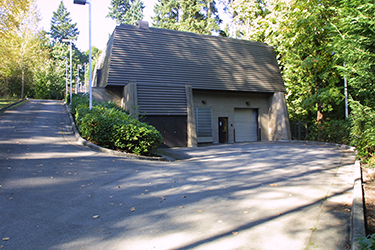|
Subscribe / Renew |
|
|
Contact Us |
|
| ► Subscribe to our Free Weekly Newsletter | |
| home | Welcome, sign in or click here to subscribe. | login |
Environment
| |
 |
February 27, 2014
King County to try new rating system for infrastructure
King County Wastewater Treatment Division and O’Brien & Co.

Franklin
|

Stewart
|
Green building rating systems have been around for about 20 years.
During this time, these standards — especially LEED — have become familiar to many. Rating systems such as LEED provide a standardized way to audit, measure and communicate building features and performance. But what about projects that aren’t buildings?
King County invests hundreds of millions each year on major infrastructure for transportation and waste disposal. Incorporating sustainable development principles into these projects has long been a priority for county leadership. But until recently, sustainable development tools and green rating systems weren’t readily available for civil infrastructure projects.
Envision is a new rating system specifically for civil infrastructure that aims to change all that. King County is one of the first agencies in the state to try out the new rating system on an upcoming pump station project in Bellevue.
A different approach
Envision was created by the Institute for Sustainable Infrastructure (ISI), a not-for-profit education and research organization founded by the American Public Works Association, American Society of Civil Engineers, and American Council of Engineering Companies in partnership with the Zofnass Program for Sustainable Infrastructure at the Harvard University Graduate School of Design.
These groups collaborated out of a shared concern about deteriorating infrastructure, rapid depletion of natural resources and the need to modernize traditional design boundaries. Their goal was a standardized framework that could guide planning and design, resulting in more sustainable and resilient infrastructure.
That framework is structured similarly to most other green systems. It contains a number of performance credits arranged within categories, uses a checklist to communicate overall project performance, and awards a certification level based on third-party verification (e.g., silver, gold, etc.). ISI also offers a suite of free online tools and resources for project support, and encourages the use of Envision as a source of guidance regardless of whether the project pursues certification.
Their approach builds on the foundation of previous rating systems, but also does things a little differently. This approach is seen most clearly in the content of the Envision categories, subcategories and credits, which constitute a broader and deeper definition of sustainability than most of the other major rating systems.
The main categories and subcategories are:
• Quality of life: purpose, community, well-being
• Leadership: collaboration, management, planning
• Resource allocation: materials, energy, water
• Natural world: Siting, Land and water, biodiversity
• Climate and risk: emissions, resilience
Envision’s benefits
King County’s Wastewater Treatment Division will pilot Envision on its Sunset and Heathfield pump stations and force main upgrade project — a major retrofit of two pump stations in southeast Bellevue, as well as the pipe that conveys wastewater from those stations.
The project is necessary to upgrade aging infrastructure and increase capacity in response to the area’s growth. The ethic of sustainability driving this project is simple: It is a facility that will continue to serve the community for a very long time.
As a service area for piloting Envision, wastewater presents a powerful opportunity. A 2010 EPA report estimates that 3 percent of national electricity consumption is related to the conveyance and treatment of water and wastewater — an equivalent to approximately 100 billion kilowatts or $7.5 billion each year. Pumps operate nonstop to convey wastewater from homes and businesses to the treatment plants where energy-intensive processes operate 24 hours a day.
From the beginning, the project team wanted to push the envelope to successfully demonstrate how early integration of sustainability can result in a robust and resilient piece of infrastructure, benefiting both ratepayers and the environment. The final pump stations and force main project will be tested against a rigorous rating system while meeting the needs of operations and maintenance staff, staying within an optimized ecological footprint and delivering on-time and on-budget.
Envision’s “broader and deeper” conception of sustainable performance can help the project team realize their goal. One advantage of using a formalized rating system is its associated credit and documentation requirements, which assist in tracking performance and provide a measure of external accountability.
But the true innovation is Envision’s support of existing practice. To select just two examples, credits within the “leadership” category award points for exceptional project management, collaboration and teamwork, and stakeholder involvement — are all elements of the project team’s existing approach. Credits within the “climate and risk” category recognize the work that King County is already doing to limit risk and maximize the resilience of their infrastructure in the face of flooding, increased heat and other anticipated impacts of a changing climate.
Clearly, excellence in project management and building durable and flexible infrastructure are of primary importance to King County. Objectives such as these do not require the use of rating systems. But Envision can provide guidance, measurement, tools and resources, and verification for a project team’s inclusion of these critical elements of sustainable design.
A forward-thinking sustainability strategy is fundamental to King County’s environmental ethic and commitment to financial stewardship. The Wastewater Treatment Division’s sustainability goals are already shaped by LEED as well as the county’s green building and sustainable development ordinance that went into effect in 2008. For projects like Sunset/Heathfield, Envision is another tool in this sustainability toolbox.
Time will tell whether Envision is the best tool for King County to measure and certify sustainable infrastructure projects, but it is clearly a concept worth trying.
Adé Franklin is a capital project manager with the King County Wastewater Treatment Division. Justus Stewart is an associate with O’Brien & Co., and leads their sustainable infrastructure initiatives.
Other Stories:
- Investing in green spaces can pay off for property owners
- LEED vs. Green Globes: How to choose
- How transparency can change the game on green building
- LEED shifts focus from design to performance
- LEED is here to stay so long as owners find it useful
- Old warehouse now a super-efficient office building
- U.S.-Mexico border crossing gets a net-zero makeover
- Historic rehab a test for performance-based codes
- Stone34 to put its deep green bona fides to the test
- No guts, more glory: Why it pays to go minimal
- State seeks to wring more value from its projects



